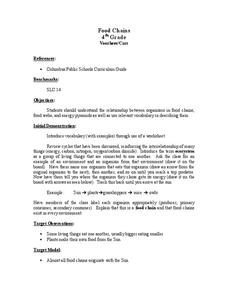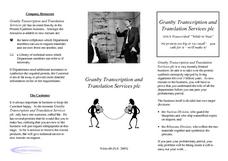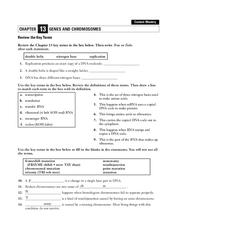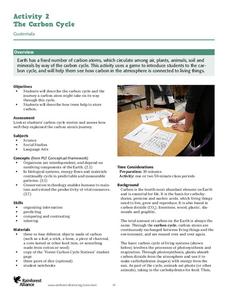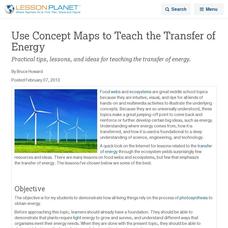Virginia Department of Education
A Designed Organism
How can you encourage pupils to demonstrate creativity while still meeting the objective of applying technical knowledge? This activity is your answer! Scientists will create an imaginary creature and prepare a graphic organizer with...
Curated OER
Organisms and Their Environment
In this organisms and their environment worksheet, students will review concepts relating to ecological studies, levels of organization in ecology, and relationships between organisms in ecosystems. This worksheet has 10 fill in the...
Curated OER
Food Chains
Fourth graders investigate food chains. They review cycles and discuss ecosystems. They select an environment and create a food chain in small groups. They write their food chain and label it for the class to evaluate. They create...
Curated OER
Blend-A-Plant Levels of Organization
Students' identify and analyze the levels of organization and the emergent properties through experimentation. Students' apply the differences in the properties of a plant before and after it has been subjected to a kitchen blender.
Curated OER
Atoms and Their Interactions
In this atoms worksheet, students will review the characteristics of elements, atoms, and isotopes. Then students will compare the difference between ionic and covalent bonds. Finally, students will balance a chemical equation. This...
Curated OER
Community Distribution
In this community worksheet, students read the definitions of primary and secondary succession and then choose a picture for each as an example. Students complete 1 true or false and 2 short answer questions.
Curated OER
Recyclers to the Rescue
Fifth graders examine the concept of the food chain and define producer, consumer, herbivore, carnivore, and omnivore. They draw a food chain for a mouse and discuss the different organisms involved in the chain, and conduct an...
Curated OER
Protists
For this protists worksheet, students will use idea maps about plantlike protist and funguslike protist characteristics to complete 4 short answer questions.
Curated OER
Mendel and Meiosis
In this meiosis instructional activity, students review vocabulary words associated with genetics, fertilization, heredity, phenotype and genotype. This instructional activity has 6 matching and 9 fill in the blank questions.
Curated OER
DNA Transcribed
In this DNA learning exercise, students describe how the cell stores all of the data needed to produce the required proteins for the body. Then they describe the ribosomes division and how is attaches itself to RNA and makes protein by...
Curated OER
Genes and Chromosomes
In this DNA activity, students will review vocabulary about the structure and characteristics of DNA and the processes of replication and mutation. 3 true or false questions, 6 matching questions, 5 fill in the blank statements.
Curated OER
Viruses and Bacteria
In this virus and bacteria worksheet, students will review 7 terms associated with bacteria and viruses by completing a crossword puzzle. Then students will place 9 vocabulary words in a table as either a bacteria or virus related term.
Curated OER
Community Distribution
In this community distribution worksheet, students will review 5 terms associated with biomes, ecosystems, and communities. Students will then match 11 terms as either relating to marine biomes or land biomes. This worksheet has 5 fill...
Curated OER
The Theory of Evolution
In this theory of evolution learning exercise, students review vocabulary words associated with evolution including the different types of evolution patters. This learning exercise has 5 true or false and 5 matching questions.
Curated OER
All in the Family: Calculating Cousins
Students view pictures of distant "cousins" to humans. They place them in order by their distance from humans. Students receive a packet of six pages featuring graphics and a cousins summary page. They work in groups to complete 5 cousin...
University of California
You Are What You Eat: Testing for Organic Compounds in Foods
We have all heard that we are what you eat, but what are we eating? An informative lesson opens with a discussion of the foods pupils have recently eaten. Then, young scientists perform four experiments on seven different foods to...
Pearson
The Chemical Context of Life
An educational presentation includes atoms, molecules, the four major elements, as well as neutrons and protons. Additionally, slides focus on atomic number, mass number, atomic weight, polar and nonpolar covalent bonding, ionic bonds,...
Rainforest Alliance
The Carbon Cycle
Scholars learn about the carbon cycle, play a carbon cycle game, and then write a story based on their role as a carbon atom during the game. After the writings, pupils analyze the carbon cycle by leading a class discussion on the material.
Curated OER
Use Concept Maps to Teach the Transfer of Energy
Practical tips, lessons, and ideas for teaching the transfer of energy.
Curated OER
Primate Evolution
In this primate evolution worksheet, students use an idea map showing how primates have evolved into the different groups to complete 1 true or false and 2 short answer questions.
Curated OER
DNA, the Awesome Thread of Life
Students examine how traits are passed to offspring. In this genetic reproduction lesson students develop a model of dna and learn about its structure, replication and function.
Curated OER
Using Word Maps to Expand Vocabulary
Looking for a good lesson on dictionary and word definition skills? The lesson presented here is for you! In it, learners utilize a worksheet, embedded in the plan, to record a word's definition(s), etymology, multiple meanings, related...
It's About Time
Factors Affecting Population Size
How do we predict future population growth? Young researchers investigate various factors affecting the size of our population. As they calculate and interpret graphs to determine factors that could potentially affect increases and...
Nuffield Foundation
Measuring the Rate of Metabolism
Plant respiration can be a difficult concept for young biologists to grasp; with a hands-on lab, learners can collect and graph data, then calculate the metabolism rate for the plants they studied. If you do not have a respirometer,...




